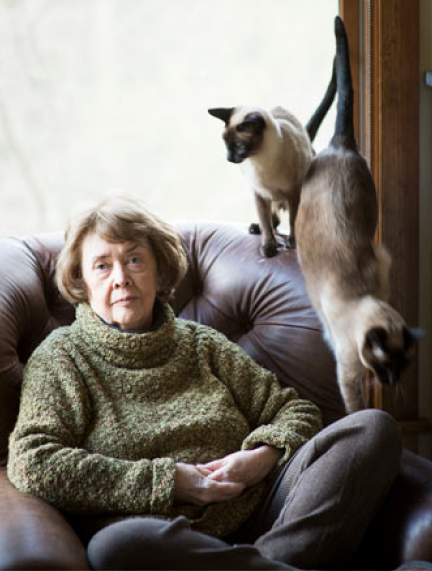Gail Godwin and
The Good Husband

Godwin was born in Alabama to a couple who divorced when she was two years old; for most of the next decade she lived with her mother and grandmother in a matriarchal setting in North Carolina. Her mother, a successful journalist and writer of romance novels, financed the family while her grandmother maintained the house. Early, Godwin decided that she preferred being a writer to being a housewife. Her mother’s marriage to a second husband when Gail Godwin was eleven, changed the girl’s life dramatically. Godwin had a hostile relationship with her stepfather, and, before long, she was no longer an only child: for her mother ended her writing career and had three more children.
Godwin was reunited with her birth father when she graduated from high school; he promised to pay her way through college but committed suicide two years later; his family, however, fulfilled his promise. Godwin first went to a traditional girls’ school, Peace College (now William Peace University) and later earned a degree in journalism from the University of North Carolina at Chapel Hill.
Godwin married another journalist on her first job in Florida, a marriage that lasted only a few months. A relative then helped her get a position at the U. S. Travel Service, operated by the U. S. Embassy in London. There she met and married a psychiatrist–that marriage, too, failed almost immediately. At the artist’s colony Yaddo in 1972, Godwin met Robert Starer, a musician; they never married but lived together in New York City and in upstate New York until his death in 2001.
After six years in London, Godwin returned to the U.S. She worked for a time in New York City, all the while writing novels that were never published. She then entered, like Flannery O’Connor earlier, the Writers’ Workshop at the University of Iowa where she earned both an M.A. Degree and a Ph.D. in English Literature. The novel she wrote for her dissertation, The Perfectionists, became her first published novel in 1970. Afterward, Godwin was able to support herself through her writing and holding temporary teaching positions.
Through the years, she has published a total of 18 novels, including her best known works, A Mother and Two Daughters (1982), A Southern Family (1987), Father Melancholy’s Daughter (1991), and The Good Husband (1994). Her most recent novel, published in 2020, is Old Lovegood Girls.
An autobiographical novelist, Godwin has used her own life history, in bits and pieces, as the subject matter for her fiction. A Southern Family presents the full story of her family history, and her most recent novel covers her time at Peace College and her early years in New York. Her novels usually feature ambitious women, like herself, who struggle to achieve success in a world dominated by men. In her earlier novels these women struggle against the system and their own self-doubts, but the women of her later fiction possess strong self assurance.
The Good Husband (1994) is arguably her most ambitious novel: it is a study of marriage, academic intrigue, artistic ambition, and death. The central character of the novel is Magna Danvers, a 58 year old professor of English who has just been diagnosed with untreatable ovarian cancer. Godwin’s description of the slow process of dying is both factual and touching. Francis Lake, Danvers’s husband is, in one reading at least, the “good husband” of the title. At one point, however, Magna identifies Death as the “good husband.” Lake met Danvers while he was studying for the priesthood and subsequently served as her caring but rather emotionally detached “house husband;” his only outside interest is collecting photos of misericords–the tiny carvings under the seats of choir chairs in European cathedrals.
Through the reaction of the academic community to Magna’s approaching death, Godwin gives clear insights into the machinations of academia: the pettiness, the competiveness, and the underlying corruption that can be part of the system. Because Magna has been a star in a small, undistinguished college, her dying becomes a major event. Godwin adds to the academic mix by introducing a popular novelist and his wife, who have recently joined the faculty. Hugo Henry seems the antithesis of the “good husband;” through him, Godwin clearly emphasizes that for the artist, nothing matters more than Art. His wife Alice, after surviving a traumatic early life, has had a successful career as an editor; she apparently has fallen in love with Hugo’s fiction but not with the man himself.
The Good Husband received mixed reviews on its publication; one reason was the obvious seriousness of its themes. For me, the breadth of Godwin’s concern makes the novel her most outstanding work.
































